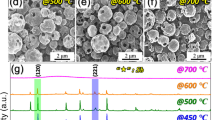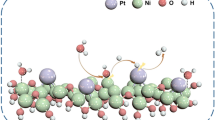Abstract
Novel FeOx/Pd/SiO2 materials have been first synthesized by the redox methods including reduction with H2 at ambient conditions. The method of the temperature-programmed reduction with hydrogen (TPR-H2) was applied to study the influence of preparation conditions on the reducibility of supported FeOx species and stability of the reduced moieties to oxygen. The decreased temperature of β-PdH decomposition, as well as the intensive hydrogen consumption at − 50 to 100 °C due to FeOx reduction, has proved deposition of FeOx species on the surface of Pd nanoparticles. The phase composition, particle size and morphology were characterized with XRD, SEM and TEM. The highly reducible FeOx/Pd/SiO2 materials exhibited a multiple increase in the catalytic activity, as compared to the starting Pd/SiO2 material, in the selective hydrogenation of triple and double carbon bonds with molecular H2 in hydrogenation of phenylacetylene in liquid phase at room temperature and 1 bar hydrogen pressure.









Similar content being viewed by others
References
Baeza A, Guillena G, Diego J, Ramón DJ. Magnetite and metal-impregnated magnetite catalysts in organic synthesis: a very old concept with new promising perspectives. ChemCatChem. 2016;8:49–67. https://doi.org/10.1002/cctc.201500854.
Hudson R, Feng Y, Varma RS, Moores A. Bare magnetic nanoparticles: sustainable synthesis and applications in catalytic organic transformations. Green Chem. 2014;16:4493–505. https://doi.org/10.1039/c4gc00418c.
Chandrababu P, Cheriyan S, Raghavan R. Aloe vera leaf extract-assisted facile green synthesis of amorphous Fe2O3 for catalytic thermal decomposition of ammonium perchlorate. J Therm Anal Calorim. 2019. https://doi.org/10.1007/s10973-019-08376-5.
Hudson R, Rivière A, Cirtiu CM, Luska KL, Moores A. Iron-iron oxide core–shell nanoparticles are active and magnetically recyclable olefin and alkyne hydrogenation catalysts in protic and aqueous media. Chem Commun. 2012;48:3360–2. https://doi.org/10.1039/c2cc16438h.
Nitta Y, Matsugi S, Imanaka T. Partial hydrogenation of phenylacetylene on copper-promoted iron catalyst. Catal Lett. 1990;5:67–72.
Shesterkina AA, Shuvalova EV, Redina EA, Kirichenko OA, Tkachenko OP, Mishin IV, Kustov LM. Silica-supported iron oxide nanoparticles: unexpected catalytic activity in hydrogenation of phenylacetylene. Mendeleev Commun. 2017;27:512–4. https://doi.org/10.1016/j.mencom.2017.09.028.
Tejeda-Serrano M, Cabrero-Antonino JR, Mainar-Ruiz V, López-Haro M, Hernández-Garrido JC, Calvino JJ, Leyva-Pérez A, Corma A. Synthesis of supported planar iron oxide nanoparticles and their chemo- and stereoselectivity for hydrogenation of alkynes. ACS Catal. 2017;7:3721–9. https://doi.org/10.1021/acscatal.7b00037.
Phua P-H, Lefort L, Boogers JAF, Tristany M, de Vries JG. Soluble iron nanoparticles as cheap and environmentally benign alkene and alkyne hydrogenation catalysts. Chem Commun. 2009;45:3747–9. https://doi.org/10.1039/b820048c.
Kelsen V, Wendt B, Werkmeister S, Junge K, Beller M, Chaudret B. The use of ultrasmall iron(0) nanoparticles as catalysts for the selective hydrogenation of unsaturated C–C bonds. Chem Commun. 2013;49:3416–8. https://doi.org/10.1039/c3cc00152k.
Kirichenko OA, Ushakov VA, Poluboyarov VA. Genesis of phase composition of supported Al–Fe–O catalysts. React Kinet Catal Lett. 1993;51(1):167–75. https://doi.org/10.1007/BF02062492.
Bonnefille E, Millet JMM, Candy JP, Thivolle-Cazat J, Bellabarba R, Tooze R, Basset J-M. Effect of rhodium traces on the reducibility of silica-supported iron particles. Catal Lett. 2012;142(8):984–90. https://doi.org/10.1007/s10562-012-0853-x.
Kirichenko OA, Kapustin GI, Nissenbaum VD, Mishin IV, Kustov LM. Evaluation of stability of silica-supported Fe–Pd and Fe–Pt nanoparticles in aerobic conditions using thermal analysis. J Therm Anal Calorim. 2014;118:749–58. https://doi.org/10.1007/s10973-014-3763-x.
Zadesenets AV, Garkul IA, Filatov IY, Plyusnin PE, Filippov TN, Asanova TI, KorolkovIV Baidina IA, Asanov IP, Korenev SV. Oxalato complexes of Pd(II) with Co(II) and Ni(II) as single-source precursors for bimetallic nanoalloys. J Therm Anal Calorim. 2019. https://doi.org/10.1007/s10973-019-08254-0.
Barbier J. Redox methods for preparation of bimetallic catalysts. In: Ertl G, Knozinger H, Weitkamp J, editors. Preparation of solid catalysts. Weinheim: WILEY-VCH Verlag GmbH; 1999. p. 526–40.
Kirichenko OA, Redina EA, Davshan NA, Mishin IV, Kapustin GI, Brueva TR, Kustov LM, Li W, Kim CH. Preparation of alumina-supported gold-ruthenium bimetallic catalysts by redox reactions and their activity in preferential CO oxidation. Appl Catal B Environ. 2013;134–135:123–9. https://doi.org/10.1016/j.apcatb.2012.12.039.
Redina EA, Greish AA, Mishin IV, Kapustin GI, Tkachenko OP, Kirichenko OA, Kustov LM. Selective oxidation of ethanol to acetaldehyde over Au–Cu catalysts prepared by a redox method. Catal Today. 2015;241:246–54. https://doi.org/10.1016/j.cattod.2013.11.065.
Redina E, Greish A, Novikov R, Strelkova A, Kirichenko O, Tkachenko O, Kapustin G, Sinev I, Kustov L. Au/Pt/TiO2 catalysts prepared by redox method for the chemoselective 1,2-propanediol oxidation to lactic acid and an NMR spectroscopy approach for analyzing the product mixture. Appl Catal A Gen. 2015;491:170–83. https://doi.org/10.1016/j.apcata.2014.11.039.
Redina EA, Kirichenko OA, Greish AA, Kucherov AV, Tkachenko OP, Kapustin GI, Mishin IV, Kustov LM. Preparation of bimetallic gold catalysts by redox reaction on oxide-supported metals for green chemistry applications. Catal Today. 2015;246:216–31. https://doi.org/10.1016/j.cattod.2014.12.018.
Lien H-L, Zhang W-X. Nanoscale Pd/Fe bimetallic particles: catalytic effects of palladium on hydrodechlorination. Appl Catal B Environ. 2007;77:110–6. https://doi.org/10.1016/j.apcatb.2007.07.014.
Kustov LM, Tarasov AL, Kirichenko OA. Microwave-activated dehydrogenation of perhydro-N-ethylcarbazol over bimetallic Pd–M/TiO2 catalysts as the second stage of hydrogen storage in liquid substrates. Int J Hydrogen Energy. 2017;42:26723–9. https://doi.org/10.1016/j.ijhydene.2017.09.009.
Olga Kirichenko O, Nissenbaum V, Kapustin G, Redina E, Vikanova K, Davshan N, Kustov L. Thermal analysis of intermediates formed during preparation of a Pt/WOx/Al2O3 catalyst for 1,3-propanediol synthesis from glycerol. J Therm Anal Calorim. 2019. https://doi.org/10.1007/s10973-019-08322-5.
Kirichenko OA, Poluboyarov VA. Waste-free methods of iron (III) oxalate complex preparation in solution for the synthesis of Al–Fe–O fuel combustion catalysts. Chem Sustain Dev. 1994;2(1):405–12.
Pinna F, Signoretto M, Strukul G, Polizzi S, Pernicone N. Pd–SiO2 catalysts. Stability of β-PdHx as a function of Pd dispersion. React Kinet Catal Lett. 1997;60:9–13.
Broadbent D, Dollimore D, Dollimore J. The thermal decomposition of oxalates. Part IX. The thermal decomposition of the oxalate complexes of iron. J Chem Soc A: Inorg Phys Theor. 1966–1971. https://doi.org/10.1039/j19670000451.
Kirichenko O, Kapustin G, Nissenbaum V, Strelkova A, Shuvalova E, Shesterkina A, Kustov L. Thermal decomposition and reducibility of silica-supported precursors of Cu, Fe and Cu–Fe nanoparticles. J Therm Anal Calorim. 2018;134:233–51. https://doi.org/10.1007/s10973-018-7122-1.
Shesterkina AA, Kozlova LM, Kirichenko OA, Kapustin GI, Mishin IV, Kustov LM. Influence of the thermal treatment conditions and composition of bimetallic catalysts Fe-Pd/SiO2 on the catalytic properties in phenylacetylene hydrogenation. Russ Chem Bull. 2016;65(2):432–9 (International Edition).
Shesterkina AA, Kirichenko OA, Kozlova LM, Kapustin GI, Mishin IV, Strelkova AA, Kustov LM. Liquid-phase hydrogenation of phenylacetylene to styrene on silica-supported Pd–Fe nanoparticles. Mendeleev Commun. 2016;26:228–30. https://doi.org/10.1016/j.mencom.2016.05.002.
Yang J, Li S, Zhang L, Liu X, Wang J, Pan X, Li N, Wang A, Cong Y, Wang X, Zhang T. Hydrodeoxygenation of furans over Pd–FeOx/SiO2 catalyst under atmospheric pressure. Appl Catal B Environ. 2017;201:266–77. https://doi.org/10.1016/j.apcatb.2016.08.045.
Lieltz G, Nimz M, Völter J, Läzär K, Guczi L. Double promotion of palladium/silica catalysts by iron and magnesium oxide in the synthesis of methanol from carbon monoxide and hydrogen. Appl Catal. 1988;45:71–83. https://doi.org/10.1016/S0166-9834(00)82394-5.
Pinna F, Selva M, Signoretto M, Strukul G, Boccuzzi F, Benedetti A, Canton P, Fagherazzi G. Pd–Fe/SiO2 catalysts in the hydrogenation of 2,4-dinitrotoluene. J Catal. 1994;150:356–63.
Juszczyk W, Pielaszek J, Karpiński Z, Pinna F. Reaction of 2,2-dimethylpropane with dihydrogen over silica-supported Pd–Fe catalysts. Appl Catal A Gen. 1996;144:281–91.
Pino N, Sitthisa S, Tan Q, Souza T, López D, Resasco DE. Structure, activity, and selectivity of bimetallic Pd–Fe/SiO2 and Pd–Fe/γ-Al2O3 catalysts for the conversion of furfural. J Catal. 2017;350:30–40. https://doi.org/10.1016/j.jcat.2017.03.016.
Acknowledgements
Electron microscopy characterization was performed in the Department of Structural Studies of Zelinsky Institute of Organic Chemistry, Moscow. The authors thank Prof. I.V. Mishin for the XRD analysis. The work was carried out with a financial support from Russian Science Foundation, Grant No. 17-73-20282. This paper belongs to the ESTAC12 Conference.
Author information
Authors and Affiliations
Corresponding author
Additional information
Publisher's Note
Springer Nature remains neutral with regard to jurisdictional claims in published maps and institutional affiliations.
Rights and permissions
About this article
Cite this article
Kirichenko, O., Strekalova, A., Kapustin, G. et al. Redox behavior of novel FeOx/Pd/SiO2 catalytic nanomaterials. J Therm Anal Calorim 138, 1913–1922 (2019). https://doi.org/10.1007/s10973-019-08786-5
Received:
Accepted:
Published:
Issue Date:
DOI: https://doi.org/10.1007/s10973-019-08786-5




